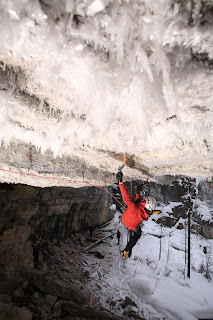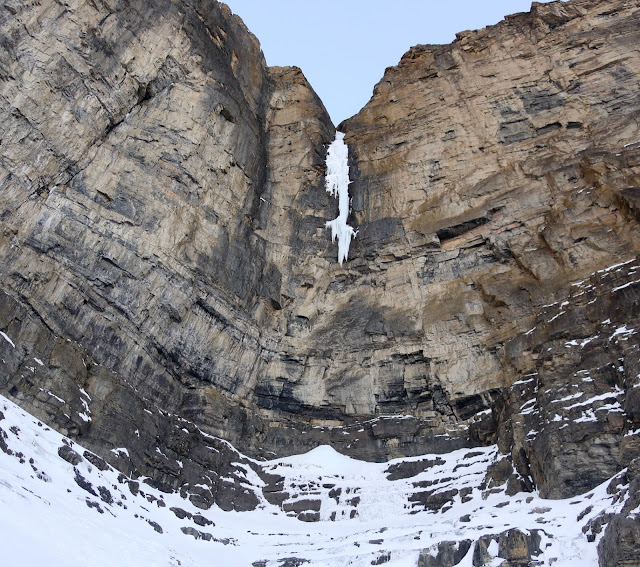Off the couch
I find that these days my interest in drytooling waxes and wanes. What a contrast to the golden age of putting metal to stone! In the late 1990s and early 2000s, along with a crew of similarly dedicated friends, I spent my winters first figure-fouring and later heel-hooking across cave roofs, arguing about whether the latest test piece was M11 or only M10+, traveling to Colorado and Quebec to compete... It was a lot of fun but it could not last.
For me, the fire went out on a late-winter day in 2003, ironically one of my best days of drytooling. I had been spending a lot of time at the Cineplex, unlearning the figure-fours that had been such a staple in the dark ages of leashes and big boots, and learning the fine art of hanging from heel spurs. On the day in question, having freshly redpointed Musashi, I turned my attention to the neighbouring Rocky Mountain Horror Picture Show. Expecting a multi-day battle working the route into submission, I surprised myself by beta-flashing it. Later that day, I re-redpointed Musashi, in spite of dropping a tool and having to haul it back up while hanging on in the middle of the big roof. But after the initial euphoria wore off, I realized that no club that would have me as member is worth belonging to. There was no way I was strong enough to be walking these routes like that. Rather, I had brought them down to my level, reduced them to a series of moderate boulder problems interspersed with perfect no-hands rests, hanging upside down from my heel spurs. With its reliance on equipment, drytooling had always walked a fine line between free and aid climbing, but with the new gear it had clearly moved into aid-climbing territory. I did not go drytooling again that season or the next one.
Since that day, I seem to get psyched on the winter version of sport climbing once every two or three seasons (I am not talking about alpine mixed climbing here, which other than using some of the same equipment, such as a helmet, might as well be a different sport). After getting pumped on some routes I used to barely break a sweat on, my wounded pride had me heading back into the canyons. At the same time, bareback style brought climbing back into mixed climbing. The last time I was psyched on drytooling was in the winter of 2009, when I decided I would actually climb an M12 (Piltdown Man in the Haffner cave) as opposed to bat-hang my way up one. It turned out to be way harder, way more fun, and way more like rock climbing than I remembered. From the moment I left the ground the clock was ticking, and it took some serious screaming to propel me to the chains; in other words, just the way "hard" (a relative term) redpointing should be. Incidentally, the moment I sent my project I lost interest again and headed up into the alpine. As Liz Taylor once said, "It's not the having, it's the getting."
The other week I spent a fun afternoon in the Haffner cave, the first time in two years I had been back there. I had no intention of getting on the harder routes, which, coming off the couch as I was, would hurt my pride along with my shoulders and elbows. But I like to reacquaint myself with old friends in the M10 range once in a while: to remember what the whole drytooling thing is all about, and to make sure I do not suck too badly. It was gratifying to see I could still get up routes like Caveman - sans the original log - without dogging, and this made me remember a few things. First, that drytooling is actually kind of fun. Second, that it is not that hard - up to a point, anyway. And third, that there some tricks that make the whole thing a lot easier. I thought I would share a few of these.
Drytooling as it was practiced back in the 1930s or so, before colour photography was invented. Learning to figure-four on Power to Burn, Waterfowl Gullies. Photo: Robert Rogoz.
For me, the fire went out on a late-winter day in 2003, ironically one of my best days of drytooling. I had been spending a lot of time at the Cineplex, unlearning the figure-fours that had been such a staple in the dark ages of leashes and big boots, and learning the fine art of hanging from heel spurs. On the day in question, having freshly redpointed Musashi, I turned my attention to the neighbouring Rocky Mountain Horror Picture Show. Expecting a multi-day battle working the route into submission, I surprised myself by beta-flashing it. Later that day, I re-redpointed Musashi, in spite of dropping a tool and having to haul it back up while hanging on in the middle of the big roof. But after the initial euphoria wore off, I realized that no club that would have me as member is worth belonging to. There was no way I was strong enough to be walking these routes like that. Rather, I had brought them down to my level, reduced them to a series of moderate boulder problems interspersed with perfect no-hands rests, hanging upside down from my heel spurs. With its reliance on equipment, drytooling had always walked a fine line between free and aid climbing, but with the new gear it had clearly moved into aid-climbing territory. I did not go drytooling again that season or the next one.
It's all aid anyhow, might as well get comfortable. Sticking the bolts into Malcontent, North Ribbon Creek. Photo: Pierre Darbellay.
Since that day, I seem to get psyched on the winter version of sport climbing once every two or three seasons (I am not talking about alpine mixed climbing here, which other than using some of the same equipment, such as a helmet, might as well be a different sport). After getting pumped on some routes I used to barely break a sweat on, my wounded pride had me heading back into the canyons. At the same time, bareback style brought climbing back into mixed climbing. The last time I was psyched on drytooling was in the winter of 2009, when I decided I would actually climb an M12 (Piltdown Man in the Haffner cave) as opposed to bat-hang my way up one. It turned out to be way harder, way more fun, and way more like rock climbing than I remembered. From the moment I left the ground the clock was ticking, and it took some serious screaming to propel me to the chains; in other words, just the way "hard" (a relative term) redpointing should be. Incidentally, the moment I sent my project I lost interest again and headed up into the alpine. As Liz Taylor once said, "It's not the having, it's the getting."
Once we got rid of heel spurs, it turned out we had to remember how to figure-four again, except this time actually holding on to the tools. Working Piltdown Man, Haffner cave. Photo: Wiktor Skupinski.
The other week I spent a fun afternoon in the Haffner cave, the first time in two years I had been back there. I had no intention of getting on the harder routes, which, coming off the couch as I was, would hurt my pride along with my shoulders and elbows. But I like to reacquaint myself with old friends in the M10 range once in a while: to remember what the whole drytooling thing is all about, and to make sure I do not suck too badly. It was gratifying to see I could still get up routes like Caveman - sans the original log - without dogging, and this made me remember a few things. First, that drytooling is actually kind of fun. Second, that it is not that hard - up to a point, anyway. And third, that there some tricks that make the whole thing a lot easier. I thought I would share a few of these.
The vast sweep of the Haffner cave. Photo: Juan Henriquez.
- Relax on the tools. I am always surprised to find I can hang on to tools much longer than friends who can climb circles around me on rock (I mean the kind you use slippers and a chalkbag for). Since they are obviously far stronger than me, I can only conclude that I must be using my limited strength much more sparingly than they are. In particular, I almost never squeeze a tool handle. On the contrary, I try to maintain as light a grip as I can get away with, often opening up my hand - kind of like open-handing as opposed to crimping on a hold. As a result I get less pumped while climbing, and recover better while shaking out.
- When climbing, move it. It is common to see people 'gerbiling' on mixed routes, their brains racing like a gerbil on its wheel, but not going anywhere. Eventually they pump out and fall off. As as soon as my pick hits a good hold, I relax on the tool and move on. Rather than looking for a placement for the other tool, I shoulder it and simply match on the tool that already is on a good placement. (Having said that, I match far less on traditional mixed routes, where committing to a single tool and having it pop could bruise more than one's ego.) On really steep routes, where I hang far below the tools, I often hook the upper grip of the placed tool with the pick of the other one, so I can use both arms to pull up to the next hold.
- Use body tension. Unlike in rock climbing where one can feel oneself spooging off a hold, in drytooling there is often no warning before a tool skates off. An especially common scenario is to have the bottom tool pop off just as the top one hits a hold. The problem is lack of body tension. After falling off unexpectedly once or twice, I remember to keep the direction of pull the same as I move past a placement, and to involve the whole body in moving around a suspect placement to keep it still - kind of like locking off on a sloper.
- Control swings. On big horizontal reaches, where an uncontrolled body swing often causes cause the tool to walk off the hold, I try to control the swing as much as possible by keeping a foot on. But, where a swing is unavoidable, I minimize it by lowering out into a cross-iron position before shrugging the trailing tool off.
- Rock climb. Rock climbing fitness helps with drytooling fitness, but much less so the other way around. I find I can go from pulling on plastic to drytooling at a reasonable (?) standard, but if all I had been doing is hanging off tool handles, the first time out sport climbing is a humbling experience.
Who knew this was actually fun? Photo: Juan Henriquez.








Hi Raph,
ReplyDeleteJust wondering where the route Malcontent is located, couldn't find any beta online about it. Does it tackle the steep dagger above the first memorial lake?
Thanks!
No, it's well before the 1st Memorial Lake. It's found on a steep wall across North Ribbon Creek from the trail maybe an hour up from the junction with the main trail. When it's formed it's obvious, 2 or 3 fun pitches of discontinuous ice. But when I hiked up Mt. Allan for a look at the ice behind it a month or so ago, it didn't look to be there.
ReplyDelete